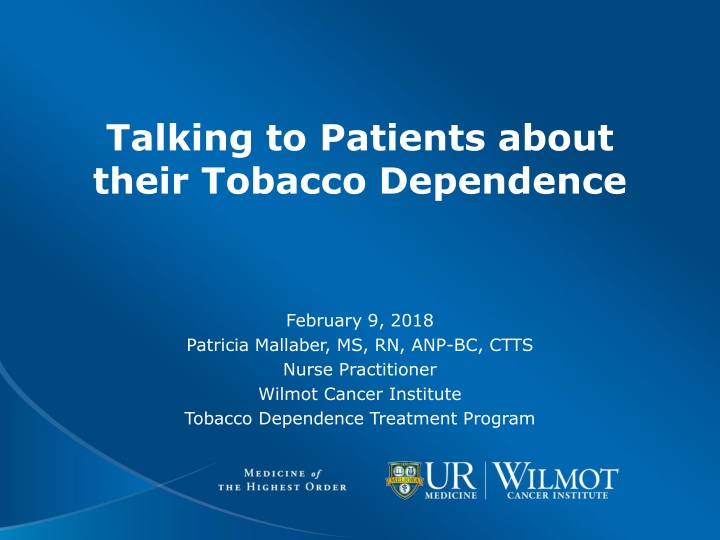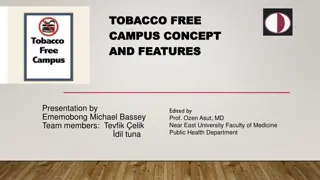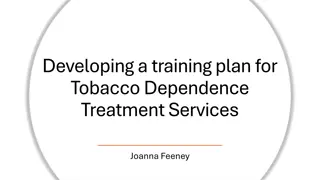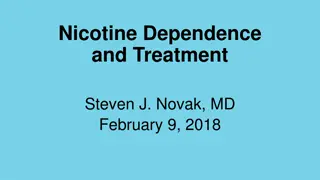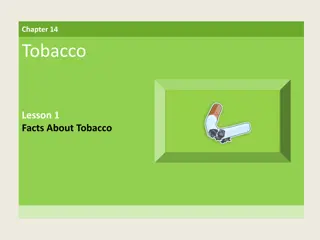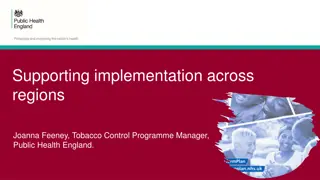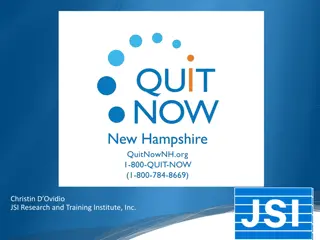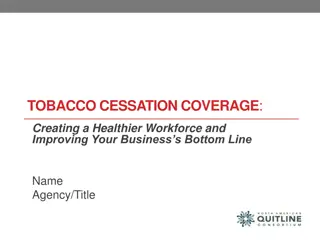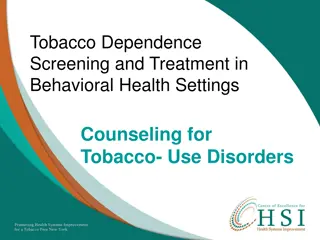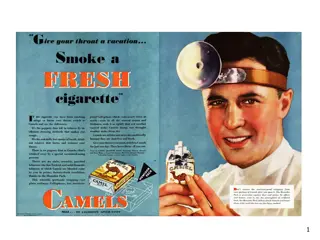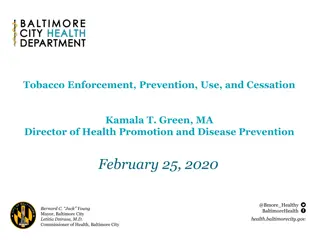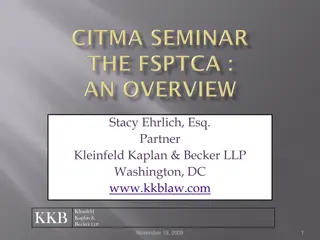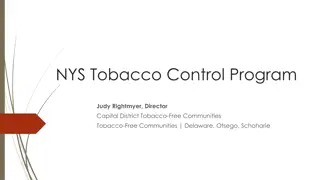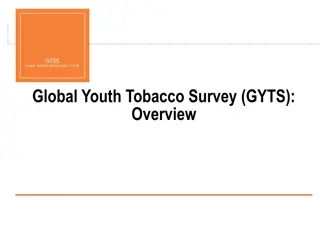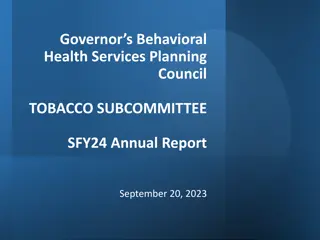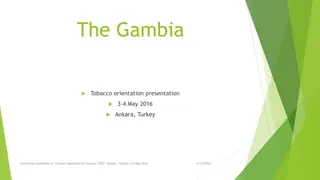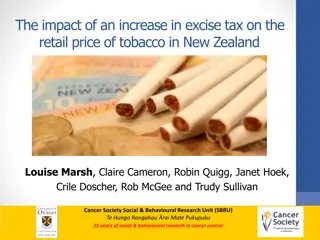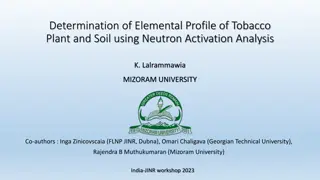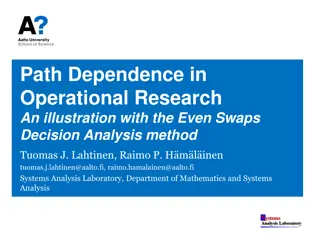Tobacco Dependence Treatment Strategies and Guidelines
Nurse Practitioner Patricia Mallaber discusses effective strategies for healthcare professionals in addressing tobacco dependence among patients. The presentation emphasizes the role of various healthcare professionals in initiating conversations, assessing readiness to quit, providing assistance, and arranging follow-up care using the "Five As" approach. Practical algorithms and statistics on smoking cessation rates among U.S. adults are also highlighted.
Download Presentation

Please find below an Image/Link to download the presentation.
The content on the website is provided AS IS for your information and personal use only. It may not be sold, licensed, or shared on other websites without obtaining consent from the author.If you encounter any issues during the download, it is possible that the publisher has removed the file from their server.
You are allowed to download the files provided on this website for personal or commercial use, subject to the condition that they are used lawfully. All files are the property of their respective owners.
The content on the website is provided AS IS for your information and personal use only. It may not be sold, licensed, or shared on other websites without obtaining consent from the author.
E N D
Presentation Transcript
Talking to Patients about their Tobacco Dependence February 9, 2018 Patricia Mallaber, MS, RN, ANP-BC, CTTS Nurse Practitioner Wilmot Cancer Institute Tobacco Dependence Treatment Program
Who should be talking to patients? Physicians Physician Assistants Nurse Practitioners Nurses Physical and Occupational Therapists Mental Health Professionals Dental Professionals Pharmacists
The Five As ASK ADVISE ASSESS ASSIST ARRANGE ASK every patient about tobacco use at every visit and document smoking status. In a clear, strong, and personalized manner urge every tobacco user to quit. Is the tobacco user willing to make a quit attempt at this time? For the patient willing to make a quit attempt, use counseling and pharmacotherapy to help him or her quit. Schedule follow- up contact, preferably within the first week after the quit date. Fiore MC, Jaen CR, Baker TB, et al. Treating Tobacco Use and Dependence: 2008 Update. Clinical Practice Guideline. Rockville, MD: U.S. Departmentof Health and Human Services. Public Health Service. May 2008.
The Five As ADVISE ASSESS ASSIST ARRANGE ASK Ask every patient about tobacco use at every visit and document smoking status. In a clear, strong, and personalized manner urge every tobacco user to quit. Is the tobacco user willing to make a quit attempt at this time? For the patient willing to make a quit attempt, use counseling and pharmacotherapy to help him or her quit. Schedule follow- up contact, preferably within the first week after the quit date. Fiore MC, Jaen CR, Baker TB, et al. Treating Tobacco Use and Dependence: 2008 Update. Clinical Practice Guideline. Rockville, MD: U.S. Departmentof Health and Human Services. Public Health Service. May 2008.
What Can You Do? Have a conversation . Among all current U.S. adult cigarette smokers, nearly 7 out of every 10 (68.0%) reported in 2015 that they wanted to quit completely. Centers for Disease Control and Prevention. Quitting Smoking Among Adults United States, 2000 2015. Morbidity and Mortality Weekly Report 2017;65(52):1457-64 [accessed 2017 Jan 24].
Treating Tobacco Use: An algorithm Does patient use tobacco now? Yes No Is patient now willing to quit? Did patient once use tobacco? Yes No Yes No Provide appropriate tobacco dependence treatments Provide motivation to quit Encourage continued abstinence Prevent relapse Fiore MC, Jaen CR, Baker TB, et al. Treating Tobacco Use and Dependence: 2008 Update. Clinical Practice Guideline. Rockville, MD: U.S. Departmentof Health and Human Services. Public Health Service. May 2008.
Tobacco Status Smoking Status Tobacco status should be assessed and documented during every encounter This is not just about smoking This includes many different types of tobacco Traditional combustible Cigarettes, e-cigarettes, vaping (standard vape or mods ), chewing tobacco (snus, snuf), hookah, cigars, mini cigars (cigarillos), pipe Some of these may vary by patient s cultural background Bidis, Betel nuts/Quid, Kreteks Use non-judgmental approach when assessing tobacco status
How to Ask Instead of Try Open ended questions Tell me how things are going with smoking Have you thought about quitting? On a scale of 1-10 how much do you want to quit smoking right now? What do you like about smoking? How do you feel about quitting? Critical or Disparaging Questions Have you quit smoking yet? Why haven t you quit smoking yet? Why are you still smoking?
The Five As ASK ADVISE ASSESS ASSIST ARRANGE ASK every patient about tobacco use at every visit and document smoking status. In a clear, strong, and personalized manner urge every tobacco user to quit. Is the tobacco user willing to make a quit attempt at this time? For the patient willing to make a quit attempt, use counseling and pharmacotherapy to help him or her quit. Schedule follow- up contact, preferably within the first week after the quit date. Fiore MC, Jaen CR, Baker TB, et al. Treating Tobacco Use and Dependence: 2008 Update. Clinical Practice Guideline. Rockville, MD: U.S. Departmentof Health and Human Services. Public Health Service. May 2008.
Advise o Urge all smokers to quit smoking o Ensure them that you can help o Reassure them that it can take multiple quit attempts to be successful o Past results do not guarantee future outcomes! o Previous failed attempts to not mean future attempts will be the same o Be non confrontational o Be encouraging
Reframe Instead of saying Try Did you know that one of the best things you can do for your health is to quit smoking? If you keep smoking you will get cancer (or a heart attack, a stroke, etc)
The Five As ASK ADVISE ASSESS ASSIST ARRANGE ASK every patient about tobacco use at every visit and document smoking status. In a clear, strong, and personalized manner urge every tobacco user to quit. Is the tobacco user willing to make a quit attempt at this time? For the patient willing to make a quit attempt, use counseling and pharmacotherapy to help him or her quit. Schedule follow- up contact, preferably within the first week after the quit date. Fiore MC, Jaen CR, Baker TB, et al. Treating Tobacco Use and Dependence: 2008 Update. Clinical Practice Guideline. Rockville, MD: U.S. Departmentof Health and Human Services. Public Health Service. May 2008.
Stages of Change Stage Pre-contemplation Contemplation Preparation Action Maintenance No plans to quit in the next 6 months Seriously considering a quit attempt in the next 6 months (Day 1-6 months) Using Medications, Following up in clinic as well as using family/friends for support Patient s Status Plans to quit in the next month >6 months smoke free No interest, lack of knowledge or awareness of potential benefits of quitting Taking Steps towards quitting Gathering information What can we do? Motivational Interviewing, Help with plan, Medication and Behavior teaching Provide support, Medication refills, plan modification (if needed), additional resources if needed Discuss relapse prevention, target date to stop medications Discuss benefits, risks, resources available Encouragement, Motivational Interviewing Prochaska & DiClemente, 1983; Prochaska, DiClemente, & Norcross, 1992
Self Determination Theory and Motivation More likely to engage in and sustain behavior change Amotivated External Introjected Identified Integrated Intrinsic I want to quit because it is consistent with my goals Being a non smoker is who I am now I do not want to quit at all My doctor says I should quit I feel great since I have quit I know I should quit More Autonomous More Controlled Ryan, R. M., & Deci, E. L. (2000). Segar & Hall (2011)
Motivational Interviewing Patient centered counseling Recognizing/Acknowledging patient s current feelings about making health change Promotes patient autonomy Assists with exploring/resolving ambivalence Open ended questions Non-judgmental Reflective listening Miller and Rollnick
Motivational Interviewing and Self Determination Theory Structure Autonomy Support Involvement Present clear and neutral information about behavior and outcomes Provide positive feedback Develop appropriate goals Elicit and reinforce self motivational statements Present options Let client make decisions Develop discrepancy Rolling with resistance Express empathy Demonstrate empathy Demonstrate understanding Avoid criticism and judgement Explore client s concerns Relatedness Competence Autonomy
Questions to Consider Consider questions that will guide your treatment and start a conversation What are your goals? How old were you when you started smoking? How many per day over the past month? What is the most you ever smoked on a regular basis? How soon after you wake up do you have your first puff? What is the longest you have ever gone without a cigarette?
Real life situations What do you NOT like about smoking? What do you like about smoking? Common Answers Smells bad Hurts my health COPD, Cancer, etc Costs too much Social Stigma Tastes bad Can no longer smoke in public Control it has over me Common Answers Helps me relax My me time Gives me an escape
Real life situations Patient Health Care Professional Quitting smoking can take time This is something that has been a part of your life for XX years- it is not realistic to think you can turn it off overnight It can take many quit attempts to quit Sometimes our first plan doesn t work out and we have to try a couple of different combinations of medications/behaviors etc. I ve tried a million times- I can t do it!
Real life situations Patient Health Care Professional There will always be some degree of stress in your life. Let s talk about other ways we can help you manage stress It s not a good time right now, I have a lot going on. I want to wait until my stress level goes and then I can work on this
Real life situations Patient Health Care Professional I can t quit because my spouse smokes too and doesn t want to quit . Consider having a conversation with your spouse and let him/her know quitting is important to you.
Real life situations Patient Health Care Professional Encourage the patient to consider all of the control that cigarettes have over them in their lives (financially, emotionally, physically) I feel like things are out of control- smoking is the only thing I have control of right now
The Five As ASK ADVISE ASSESS ASSIST ARRANGE ASK every patient about tobacco use at every visit and document smoking status. In a clear, strong, and personalized manner urge every tobacco user to quit. Is the tobacco user willing to make a quit attempt at this time? For the patient willing to make a quit attempt, use counseling and pharmacotherapy to help him or her quit. Schedule follow- up contact, preferably within the first week after the quit date. Fiore MC, Jaen CR, Baker TB, et al. Treating Tobacco Use and Dependence: 2008 Update. Clinical Practice Guideline. Rockville, MD: U.S. Departmentof Health and Human Services. Public Health Service. May 2008.
What do think are some of your triggers?? Patient Health Care Professional Think of other things to hold in hand while on phone (lollypop, toothpicks, straw) Talking on the phone Consider not having cigarettes within reach in the car (put in trunk) Driving in the car Try washing dishes/brushing teeth right after eating After meals Try to keep busy (puzzles, games, hobbies) When I am bored Learning other strategies to deal with stress (counseling, breathing exercises, yoga, meditation) When I feel stressed
Real life situations Patient Health Care Professional I ve tried all of the medicines- none of them work Let s go through what you ve tried before Did you know there are 7 FDA approved medications to help patients quit smoking?
Real life situations Patient Health Care Professional Unfortunately none of the medications we have available are meant to make you quit smoking- they are meant to help the process be more comfortable for you I took <<medicine>> once but it didn t work- I still smoked!
Real life situations Patient Health Care Professional Discuss chemical components in a cigarette smoke (one of which is nicotine) Review rationale and safety of Nicotine Replacement I don t want to use the patch and put chemicals in my body I don t want to get addicted to the patch
The Five As ARRANGE ASK ADVISE ASSESS ASSIST ASK every patient about tobacco use at every visit and document smoking status. In a clear, strong, and personalized manner urge every tobacco user to quit. Is the tobacco user willing to make a quit attempt at this time? For the patient willing to make a quit attempt, use counseling and pharmacotherapy to help him or her quit. Schedule follow- up contact, preferably within the first week after the quit date. Fiore MC, Jaen CR, Baker TB, et al. Treating Tobacco Use and Dependence: 2008 Update. Clinical Practice Guideline. Rockville, MD: U.S. Departmentof Health and Human Services. Public Health Service. May 2008.
Barriers for follow ups Patient Health Care Professional Identify other ways you can follow up Phone Electronically (EMR based email) I have too many visits/copays- I can t come back for a follow up that soon I don t have a ride
Common Responses at Follow Up Visits Patient Health Care Professional Focus on positives and achievements You went 2 weeks without smoking! You are still working on this and you haven t given up! I failed, I am still smoking I am not doing well
Approaching Slip Ups Patient Health Care Professional Acknowledge the slip, help the patient recognize and learn from it Let the slip slide! Congratulate them for not relapsing to their previous smoking pattern Follow up visit: I quit for 2 weeks and then my friend passed away so I had one
About Relapse Prevention of relapse begins at the beginning phases of the quit journey Anticipating triggers, strategies Pharmacologic Support Patients who relapse often feel negative feelings of shame, guilt and blame Congratulate them for time they spent tobacco free Help to focus on what they learned (both negative and positive) from this quit attempt Assist in starting new plan
Offer Alternate Resources Local Tobacco Treatment Providers/Classes/Groups NY State Smokers Quitline Employer programs Nicotine Anonymous American Cancer Society Quit for Life Program American Lung Association Freedom from Smoking Program Smart Phone/Tablet Apps/Text Programs Websites to visit Social Media Pamphlets and Handouts
Ongoing Support Reassurance that we are here for them no matter what If relapse occurs we will have open line of support to offer assistance no judgement We can help them try again Next week Next month Whenever!
For those who are unwilling The 5 R s Relevance Do you feel that quitting smoking is an important thing for you to do for yourself? Risks What effect do you think your continued smoking will have on you/others around you? Rewards Can you think of some potential benefits of quitting smoking for you? Roadblocks What are some barriers you feel to quitting? Repetition Repeat every time a patient visits.
Teaching for Family/Friends Do Don t Ask how they are doing and feeling Be supportive when they need to talk Help distract them through cravings ( let s go on a walk ) Be patient and respectful-this process is done at the quitter s pace Be positive and encouraging Help remind them of the reasons they want to quit Be patient with them Judge Nag Tease Offer them any tobacco products Smoke around them Scold them or make them feel guilty for slip ups
Consider having a Tobacco Treatment Champion Passionate person in clinic/work place This person can take lead for tobacco treatment, education for staff May be able to provide individual counseling, follow up for patients in between visits This person may seek additional training/become certified in tobacco treatment
CONTACT PATRICIA_MALLABER@URMC.ROCHESTER.EDU
